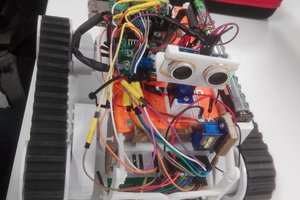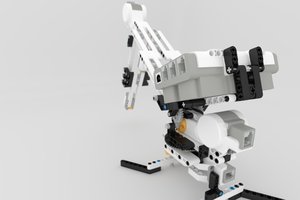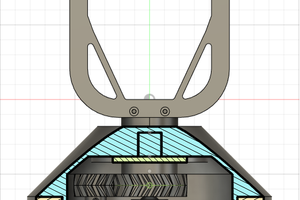Colour sorting machine for Lego
Automatically sort random Lego pieces by colour!
Automatically sort random Lego pieces by colour!
To make the experience fit your profile, pick a username and tell us what interests you.
We found and based on your interests.
40mm_pipe_bend_100deg.stlStandard Tesselated Geometry - 3.40 MB - 06/17/2024 at 19:51 |
|
|
off_centre_mass.stlStandard Tesselated Geometry - 953.79 kB - 06/17/2024 at 19:51 |
|
|
Vee_channel_end_scoop.stlStandard Tesselated Geometry - 810.63 kB - 06/17/2024 at 19:51 |
|
|
tube_spindle_mount.stlStandard Tesselated Geometry - 314.14 kB - 06/17/2024 at 19:51 |
|
|
sensor_housing.stlStandard Tesselated Geometry - 715.12 kB - 06/17/2024 at 19:51 |
|
A bit more tidying up, addition of a hopper and chute to load Legos into the drum, some fine tuning of the angles and software and it's done!
It's not perfect but it is really fun to watch. The main remaining issue is that the scoops inside the drum sometimes pick up quite a few pieces, which then overwhelm the vibe feeder and they end up tailgating each other past the sensor. Something to tweak later. I'd also like to add a touchscreen with start/stop buttons and some readouts of brick counts, speeds, etc. Other ideas in the comments please!
First time putting together all the parts:
I've chopped up something like 2.5metres of 2020 aluminium extrusion and turned it into a more permanent, more rigid frame for the drum feeder, vibration feeder and sensor head:
The drum is belt driven from a DC motor/reducer gearbox running at about 200rpm. I needn't have worried about the belt wandering off the drum - it's absolutely fine, without any need for additional guides or track to keep it centred.
Everything's adjustable - angles, clearances, etc. - so the next steps are to do some tuning to get it feeding reliably and quickly, before finally integrating it with the diverter and output bins.
The drum feeder is looking good now. After a bit of trial and error making paddles/scoops from card I've committed to a 3D printed design that works well enough for a first attempt. Physically positioning all the various parts was getting really tricky using the wooden lash-up so have also started the 'finished' build in 2020 profile and M5 fittings.
I think I'll try a belt-drive to power it, from a DC motor and reducing gearbox. Only problem with a belt is that the drum has a slight draft to the sides, meaning that the belt will undoubtedly tend to wander off...
So after a long break to get some other projects finished, I'm back to the Lego sorter and its drum feeder.
It may look like a food container, sat on some rollers, and with a hole in the lid, but it's much more than that! Actually, not really. That's exactly what it is.
Using a bench supply to control the current (and therefore speed/vibration frequency) of the vibrating feeder was getting a bit annoying, so I finally took the plunge and added an H-bridge driver and PWM control. Initially I tried an L9110S-based module (very cheap on the 'bay) but it wasn't up to it and kept overheating. Plus it doesn't support 'coasting' so ended up being quite noisy and inefficient.
I swapped it out for an L298N-based module (almost as cheap) which is much better. By driving the ENABLE line with PWM, and holding the IN1/IN2 inputs H/L for fixed direction, it's possible to employ coasting, which keeps the motor happier.
However, the Arduino's built in PWM frequency (977Hz) is very noisy, and changing the prescaler to get other values is no better (3.9kHz is also noisy, 31kHz is too fast for the driver). So ended up with a bit of code to set it at about 15kHz, which is perfect. Pretty much silent (to my deaf ears anyway) but with smooth power control and no overheating.
Plus, the L298N has dual outputs, so I've still got a spare channel I can use to control the drum feeder's motor, when I get to that stage.
After quite a lot of trial and error on the feeder, I've settled on a design where one end is a hinge, forcing the vibrating motion to be confined to up-down only, and with low amplitude at the hinge end, and a large amplitude at the free end. It seems to work well at separating parts as long as there aren't too many at once:
Obvs this is a dirty quick prototype using scraps lying around, I'll do a neat version one day out of profile aluminium...
Ok, definitely last log on colour sensing! I think it's good enough now.
I've significantly sped up the colour sampling code by using the low-level read16() rather than the getRawData() library function, since the latter includes an unnecessary delay equal to the integration time. Another significant step is to read a few (e.g. 5) samples in quick succession starting as soon as the brick's presence is detected, and then picking the RGB measurement corresponding to the brightest (largest C) of the series. Colour accuracy seems best when the reflectance is as high as possible.
Timing was still a bit tight, but I noticed that I could make the diverter stepper motor go a bit faster than previously thought - the battery I'd been using was flat! Charging it up made quite a difference. Using the slo-mo mode on my phone, and stepping through the videos frame-by-frame, I've measured the time it takes for a piece to fall through the diverter at 160-190ms. By contrast, the diverter takes - at most - 125ms to move. In fact, when it only needs to move one place (nearest neighbour) it has finished moving before the piece even enters the top of the tube! Eeeek that's fast!
A bespoke, 3D-printed 'hood' and 'scoop' part, painted inside with BLK3.0, now cuts out most of the stray light, and helps funnel the pieces into the diverter.
Oh, one last thing, for pieces that are classified by hue as "white, grey or black" the code now does an additional classification based on brightness to attempt to distinguish between black and white/grey.
Video to follow....
With a light sensor positioned to detect the light from the illuminating LED it can now sense when a brick arrives and leaves. If two bricks come down together (of different colours) we need to make sure the diverter isn't moving whilst one is in transit else it will jam. So we need to implement a 'hold off' period where new bricks don't trigger a change of position:
This can be implemented using a state machine, with rising- and falling-edge interrupts driving some of the changes of state:
This is now coded up and seems to work ok, just need to adjust the value of T (about 100ms) to get the best compromise between fast changing of output bins and no jamming. (Note that the sensor output is inverted: high level means brick present, low = no brick.)
Also, I've added a thin piece of black card between the light source and colour sensing chip, plus BLK3.0 black paint on all the surfaces, to try and block any direct illumination which I'm sure will help:
[Update: this is now working very nicely, with pretty much zero instances of jamming the mechanism. Even the very smallest Lego pieces (4-5mm) get correctly detected. The remaining challenge is to ensure they are fed in one-at-a-time with ~100msec or more gaps between them.]
I've implemented an algorithm for colour classification that seems to work ok:
This seems to work ok for big bricks, but small pieces will be a problem because they are moving too quickly to get more than 2 or 3 samples total, so the "M out of N" consistency check will fail. This is exacerbated by using a fixed (non-vibrating) section of feeder which needs to be at a fairly steep angle to ensure pieces don't stop, but means they're moving pretty fast by the time they reach the sensor:
But it works well enough as a starting point:
An alternative plan I'll try next is to position a second light sensor above the feeder, trained to detect the light from the illuminating LED. When the light dims sufficiently, we can be pretty sure there's a piece in just the right place, so should be able to exactly time a single colour measurement (taking only 5msec) rather than needing a whole string of them. [Update: yes this approach works very well! More to follow in next log.]
Create an account to leave a comment. Already have an account? Log In.
Become a member to follow this project and never miss any updates

 Paul Crouch
Paul Crouch
 Alan Chambers
Alan Chambers
 Stryker295
Stryker295
 caver.adam
caver.adam